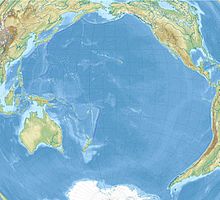Maria Theresa Reef
alleged position of the Maria Theresa reef |
The Maria Theresa Reef or Maria Theresa Island is said to be located south of the Tuamotu Archipelago in the Pacific Ocean . Its existence, as well as that of the Ernest Legouvé Reef, has not been clarified; it may be phantom islands . Accordingly it is noted in some atlases, not in others. Its location off the usual shipping routes is a major reason for the insufficient verification of its existence.
On November 16, 1843, the US was whalers Maria Theresa under Captain Asaph P. Taber at 36 ° 50 ' S , 136 ° 39' W . The logbook reports contradictingly of breakers (breakers / surf) or breaches (the blow of whales ). The earliest surviving news that Taber had discovered a reef or island is on March 2, 1844, in The Friend , Honolulu newspaper . The coordinates of 37 ° 0 ′ S , 151 ° 13 ′ W (south of the Austral Islands ) shown here served as the basis for entries in nautical charts and atlases until 1983. A review of the logbook of the "Maria Theresa" by the British Hydrographic Institute led to the correction of the coordinates by more than 1000 km to the east, at least on nautical charts, while many atlases continue to use the old coordinates. A few attempts in the 20th century to find the island again were unsuccessful for both traditional positions.
Satellite images also suggest that the reef does not exist, at least in the present. However, since neither a coral reef that has since sunk below sea level nor the existence of the Maria Theresia Reef can definitely be ruled out, the nautical charts continue to show the reef for safety reasons.
Jules Verne immortalized it literarily in his two novels The Children of Captain Grant and The Mysterious Island . In both he describes it as a habitable island, which Captain Grant and two of his sailors used as a refuge for several years after a shipwreck. At the end of the first story, the criminal Ayrton is exposed on Tabor, who is rescued in the second story by the refugees who landed on the island of Lincoln .
On French nautical charts, the reef is shown as Tabor , apparently a false transfer of the discoverer name Taber .
Web links
Individual evidence
- ↑ The Friend, March 2nd, 1844; Honolulu 1844; quoted after: American activities in the Central Pacific, 1790 - 1870: a history, geography and ethnography pertaining to American involvement and Americans in the Pacific taken from contemporary newspapers etc. / ed. by Ralph Gerard Ward, Vol. 4; Ridgewood, NJ 1967 (p. 191)


